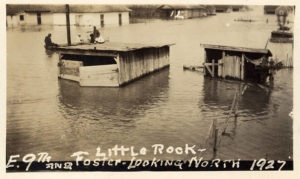calsfoundation@cals.org
Exploring the Great Mississippi River Flood of 1927
The Great Mississippi River Flood of 1927 was one of the largest natural disasters to affect Arkansas, as well as the largest and most destructive flood in our nation’s history, inundating over 27,000 square miles. Arkansas was the hardest hit of the states: Of the seventy-five counties in Arkansas, thirty-six of them were under water. In some places, the water was thirty feet deep.
 The CALS Butler Center’s new interactive web exhibit uses photographs from its Disaster Photographs collection, Pulaski County Disaster Photographs collection, and other resources to allow visitors to see and read about how this event affected Arkansas.
The CALS Butler Center’s new interactive web exhibit uses photographs from its Disaster Photographs collection, Pulaski County Disaster Photographs collection, and other resources to allow visitors to see and read about how this event affected Arkansas.
The eastern half of the state was most damaged by the flood, but the devastation stretched as far as the state’s western border. Over 2,000,000 acres of farmland were flooded, and more than 100 people lost their lives.

The flood resulted in a huge displacement of people as tens of thousands of Arkansans became refugees in their own state. The suffering was immense and widespread. Thousands of people fleeing the rising water were forced to live in tent cities, or in some cases railroad boxcars, if they found any shelter at all. Countless farms and businesses were lost.
The economic costs for the state were also staggering. The flood had a profound impact on how Arkansans viewed their government, and the resulting political and social changes altered the state’s history. Also read more about the Flood of 1927 on the CALS Encyclopedia of Arkansas.
Explore the 1927 Flood web exhibit here.




